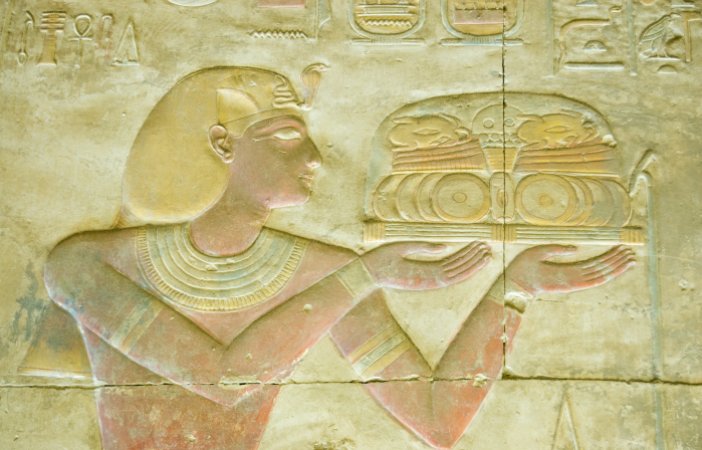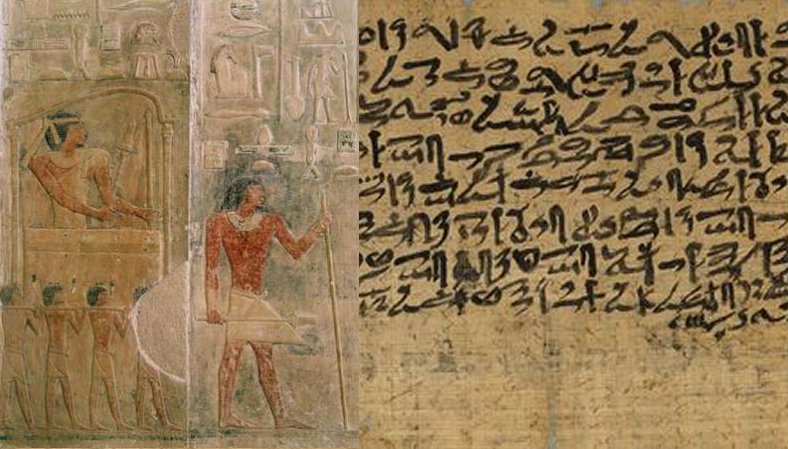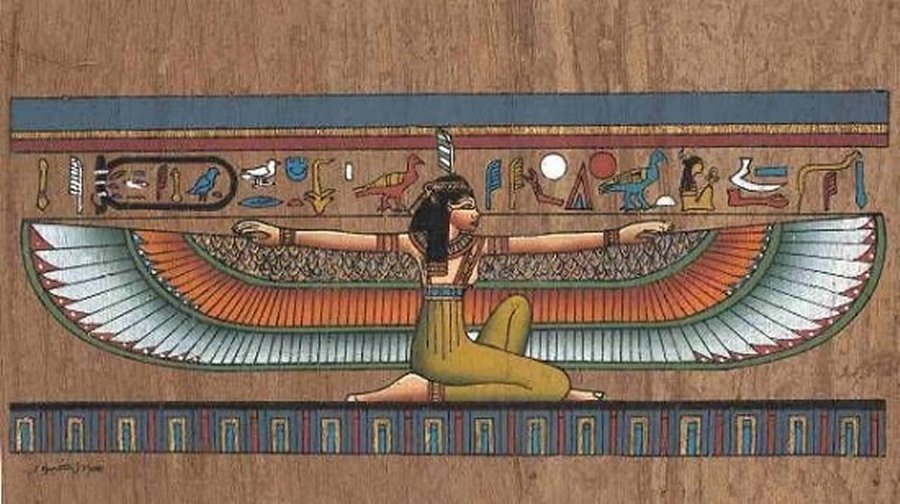Table Manners And First Code Of Correct Behavior Were Introduced In Egypt 2,500 B.C. By Ptahhotep
Ellen Lloyd - AncientPages.com - Louis XIV, known as Louis the Great or the Sun King (1638 – 1715), couldn’t stand bad table manners. The Sun King is today remembered as a royal who preferred art over politics. He was also a king who introduced complicated rules for doing anything, including dining.

Ancient Egyptians were familiar with table manners in 2,500 B.C. Credit: BasPhoto - Adobe Stock
Around 1669, King Louis the Great became the “first person in Europe to offer his guests a place setting with knives, forks, and spoons; he ordered the knives should have rounded ends to prevent injury should things turn ugly.” 1
Forks were still a new trend, and many were reluctant to use forks. “When the first forks appeared, they caused a sensation, but getting people to use them for eating was not easy. Not only were forks very expensive, but they were also disapproved by the Church, and people did not know how to use them.” 2
The Church argued God had created humans with fingers so they could touch and eat God’s food. People may have listened to the Church, but obviously, they didn’t pay much attention to these warnings. The Church’s disapproval did not stop people from producing gold and silver forks that wealthy families in Tuscany wanted to have at the dining table.

Left: Ptahhotep on a palanquin, relief from his tomb. Werner-Forman Archive/Heritage-Images - Right: The Maxims of Ptahhotep, Public Domain
Slowly, eating etiquette evolved in Europe. People washed their hands before dinner and stopped blowing their noses into their palms during the meal.
One would think table manners were introduced in Europe, but that’s wrong. Europeans suddenly felt they had “discovered” what should be considered proper manners at the table. However, these table manners and dining etiquette were introduced in Egypt in about 2,500 B.C.
“During the Fifth Dynasty (2,500 B.C. – 2,350 B.C.), Egyptian Vizier Ptahhotep, occasionally known as Ptahhotep I, Ptahhotpe or Ptah-Hotep, wrote several instructions based on his wisdom and experiences.
His precious text contains advice on how to live your life, and much of what he wrote is still highly relevant today.” 3
The first historical evidence of correct behavior can be traced to Ptahhotep’s book The Instructions of Ptahhotep.
Knowledge of our ancestors’ views of correct manners became evident with the discovery of the ancient Egyptian Prisse Papyrus. The text datable to the Middle Kingdom was found inside the coffin of Pharaoh Sekhemre-Wepmaat Intef of the 17th Dynasty at Thebes.

Maat - Ancient Egypt’s Most Important Religious Concept - Read more
The papyrus document contains the last two pages of the Instructions of Kagemni, followed by the only complete surviving copy of the Instructions of Ptahhotep.
The precious papyrus that predates the Bible by about 2,000 years now resides in the Paris antiquities collection.
One must admit that even from our modern perspective, it’s a fascinating ancient text that gives so much advice on behaving in ordinary situations.
“In the company of one’s superior, the book advises, “Laugh when he laughs.” It suggests overlooking one’s quiddities with a superior’s philosophy, “so thou shalt be very agreeable to his heart.” There are numerous references to the priceless wisdom of holding one’s tongue, first with a boss: “Let thy mind be deep and thy speech scanty,” then with a wife: “Be silent, for it is a better gift than flowers.” 4
Vizier Ptahhotep was, in many ways, a man ahead of his time. When the Bible was written, his 2,500-year-old advice had been well circulated throughout the Nile delta of Egypt and the fertile crescent of Mesopotamia. Scholars who have studied the Bible have discovered strong echoes of The Instructions Ptahhotep in the Holy Book. The Bible frequently mentions food in various contexts, and the vizier’s guidelines, especially in Proverbs, contain instructions on how to eat and prepare food.
To embrace the central concept of Egyptian wisdom, one must first understand the importance of the goddess Maat, which symbolizes cosmic order and social harmony.
Students of the Old Testament will find many themes reflecting Egyptian instructions written by Ptahhotep, who covered all topics, including table manners.
Updated on January 5, 2024
Written by Ellen Lloyd – AncientPages.com
Copyright © AncientPages.com All rights reserved. This material may not be published, broadcast, rewritten or redistributed in whole or part without the express written permission of AncientPages.com
Expand for references- Nicholas Clayton - A Butler's Guide to Table Manners
- Sutherland - Troublesome Ancient History Of Forks Started In Tuscany, Italy In 11th Century, AncientPages.com
- Ellen Lloyd - Secrets Of Maxims Of Ptahhotep – Ancient Egyptian Wisdom Is Still Relevant Today. AncientPages.com
- Panati, Charles - Extraordinary Origins of Everyday Things
- Fontaine, Carole R. "A Modern Look at Ancient Wisdom: The Instruction of Ptahhotep Revisited." The Biblical Archaeologist44, no. 3 (1981): 155-60. Accessed October 26, 2020. doi:10.2307/3209606.
More From Ancient Pages
-
 Skull Reveals Little Foot Was Capable Of Different Head Movements Than Modern Humans
Human Beginnings | Mar 25, 2020
Skull Reveals Little Foot Was Capable Of Different Head Movements Than Modern Humans
Human Beginnings | Mar 25, 2020 -
 Police Forces That Kept Order In Ancient Streets
Ancient History Facts | Jun 12, 2018
Police Forces That Kept Order In Ancient Streets
Ancient History Facts | Jun 12, 2018 -
 On This Day In History: Franco-Mexican War – Mexico City Captured By French Troops – On June 7, 1863
News | Jun 7, 2016
On This Day In History: Franco-Mexican War – Mexico City Captured By French Troops – On June 7, 1863
News | Jun 7, 2016 -
 Thousand-Year-Old Farming Techniques And Irrigation Systems Can Be Used To Mitigate Climate Change
Archaeology | Mar 7, 2018
Thousand-Year-Old Farming Techniques And Irrigation Systems Can Be Used To Mitigate Climate Change
Archaeology | Mar 7, 2018 -
 Rare Ancient Human Footprints Found On Gower Peninsula, Wales Are 7,000 Years Old
Archaeology | Mar 8, 2017
Rare Ancient Human Footprints Found On Gower Peninsula, Wales Are 7,000 Years Old
Archaeology | Mar 8, 2017 -
 18,000-Year-Old Seashell Was Musical Wind Instrument Used By Magdalenian People
Artifacts | Feb 11, 2021
18,000-Year-Old Seashell Was Musical Wind Instrument Used By Magdalenian People
Artifacts | Feb 11, 2021 -
 Major Archaeological Discovery Of A 7,000-Year-Old Settlement In Miami – But Its Future Is In Danger
Archaeology | Feb 10, 2023
Major Archaeological Discovery Of A 7,000-Year-Old Settlement In Miami – But Its Future Is In Danger
Archaeology | Feb 10, 2023 -
 Siberia Had A Major Skull Surgery Center 2,500 Years Ago
Ancient History Facts | Jul 19, 2019
Siberia Had A Major Skull Surgery Center 2,500 Years Ago
Ancient History Facts | Jul 19, 2019 -
 Thriving Faiyum Oasis Declined And Was Abandoned Due To Climate Change
Archaeology | Jan 26, 2021
Thriving Faiyum Oasis Declined And Was Abandoned Due To Climate Change
Archaeology | Jan 26, 2021 -
 88 Ice Age Human Footprints In Utah Desert Shed New Light On Ancient Americans
Archaeology | Aug 11, 2022
88 Ice Age Human Footprints In Utah Desert Shed New Light On Ancient Americans
Archaeology | Aug 11, 2022 -
 On This Day In History: Agatha Christie Known As ‘Queen Of Crime’ Died – On Jan 12, 1976
News | Jan 12, 2017
On This Day In History: Agatha Christie Known As ‘Queen Of Crime’ Died – On Jan 12, 1976
News | Jan 12, 2017 -
 Sacred Artifact With Mystical Powers – The Legend – Part 1
Ancient Mysteries | Apr 24, 2019
Sacred Artifact With Mystical Powers – The Legend – Part 1
Ancient Mysteries | Apr 24, 2019 -
 Large Palace Discovered At Mayan City Of Kulubá In Yucatan, Mexico
Archaeology | Dec 27, 2019
Large Palace Discovered At Mayan City Of Kulubá In Yucatan, Mexico
Archaeology | Dec 27, 2019 -
 Earliest And Largest Scythian Princely Tomb Discovered In Siberia By Swiss Archaeologist
Archaeology | Jan 16, 2018
Earliest And Largest Scythian Princely Tomb Discovered In Siberia By Swiss Archaeologist
Archaeology | Jan 16, 2018 -
 Edøy Discovery: Traces Of 1,000-Year-Old Ship Burial Detected In Norway
Archaeology | Nov 24, 2019
Edøy Discovery: Traces Of 1,000-Year-Old Ship Burial Detected In Norway
Archaeology | Nov 24, 2019 -
 Hayk – Legendary Patriarch And Founder Of Armenia Who Defeated King Bel Of Babylon
Featured Stories | Feb 10, 2022
Hayk – Legendary Patriarch And Founder Of Armenia Who Defeated King Bel Of Babylon
Featured Stories | Feb 10, 2022 -
 Evidence Of Dual Mass Extinctions 260 Million Years Ago – Found
Fossils | Apr 10, 2023
Evidence Of Dual Mass Extinctions 260 Million Years Ago – Found
Fossils | Apr 10, 2023 -
 The Knap Of Howar: One Of The Oldest And Well-Preserved Neolithic Complexes Orkney, Scotland
Featured Stories | Mar 2, 2017
The Knap Of Howar: One Of The Oldest And Well-Preserved Neolithic Complexes Orkney, Scotland
Featured Stories | Mar 2, 2017 -
 Two Scribes Penned 8th Century ‘Samaria Ostraca’ Inscriptions Unearthed In Samaria
Archaeology | Jan 23, 2020
Two Scribes Penned 8th Century ‘Samaria Ostraca’ Inscriptions Unearthed In Samaria
Archaeology | Jan 23, 2020 -
 Mysterious Ancient Vanished Civilization With Unusual Physical Characteristics – Survivors Of The World’s First Race? – Part 1
Ancient Mysteries | Aug 17, 2020
Mysterious Ancient Vanished Civilization With Unusual Physical Characteristics – Survivors Of The World’s First Race? – Part 1
Ancient Mysteries | Aug 17, 2020
